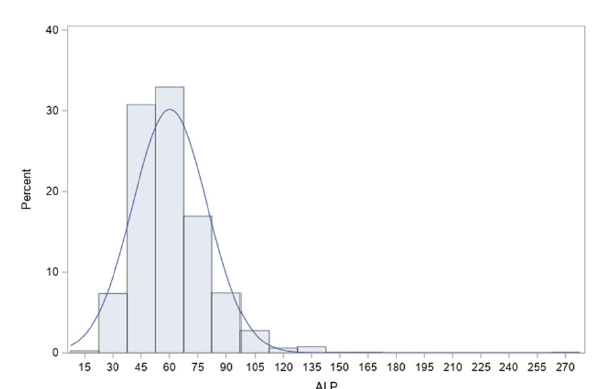Normal alkaline phosphatase levels are dependent on race/ethnicity

Normal alkaline phosphatase levels are dependent on race/ethnicity: National Health and Nutrition Examination Survey data
Objective
The range of normal serum alkaline phosphatase is not well defined. We used data from the National Health and Nutrition Examination Survey from 2009 to 2016 to generate normal ranges for a racially diverse sample of healthy adults.
Methods
Respondents 18 years or older were included. Conditions known to elevate alkaline phosphatase were cause for exclusion. Alkaline phosphatase was measured using a colorimetric method based on standardised National Health and Nutrition Examination Survey protocols. Because alkaline phosphatase values were not normally distributed, log transformation was used. We calculated upper limits of normal (97.5 percentile), stratified by sex and race/ethnicity, and 90% CIs for the upper limits of normal.
Results
1199 respondents (673 female, 526 male) had body mass index from 18.5 to less than 25. Upper limits of normal were highest among Hispanics (123.2 IU/L (90% CI 110.2 to 136.7) for females; 123.8 IU/L (90% CI 112.0 to 135.1) for males), followed by African Americans (109.9 IU/L (90% CI 97.3 to 122.4) for females; 116.3 IU/L (90% CI 105.0 to 126.1) for males) and whites (97.1 IU/L (90% CI 91.0 to 103.4) for females; 109.6 IU/L (90% CI 102.1 to 116.3) for males). Asian American/Pacific Islander respondents had the lowest results: 93.8 IU/L (90% CI 88.2 to 99.5) for females and 95.3 IU/L (90% CI 88.1 to 102.1) for males.
Conclusions
The upper limit of normal alkaline phosphatase varies by race/ethnicity in a large US sample with body mass index of 18.5<25.
